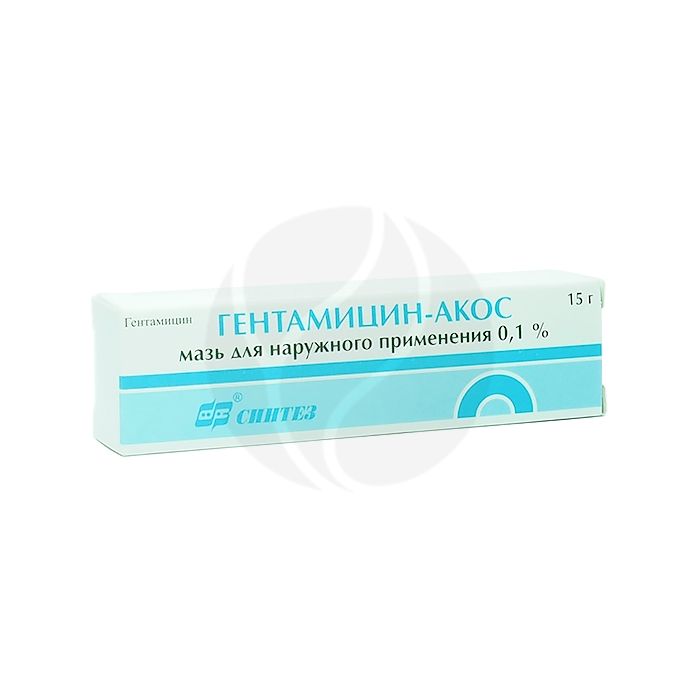Gentamicin Akos ointment for external use 0.1%, 15 g
Russian Pharmacy name:
Гентамицин Акос мазь для наружного применения 0,1%, 15 г
Infectious and inflammatory diseases caused by microorganisms sensitive to gentamicin: pyoderma (including gangrenous), superficial folliculitis, furunculosis, sycosis, paronychia, infected seborrheic dermatitis, infected acne, secondary bacterial infection in fungal and viral skin infections, infected skin wounds various etiologies (burns, wounds, difficult healing ulcers, insect bites), infected varicose ulcers.
The method of application and dosage regimen of a particular drug depends on its form of release and other factors. The optimal dosage regimen is determined by the doctor. It is necessary to strictly observe the compliance of the used dosage form of a particular drug with the indications for use and the dosage regimen.
Outwardly - 3-4 times / day.
Gentamicin (in the form of sulfate) 100 mg
Hypersensitivity to gentamicin and other antibiotics of the aminoglycoside group.
Carefully
If necessary, use on extensive skin surfaces - neuritis of the auditory nerve, myasthenia gravis, parkinsonism, botulism, renal failure (including severe renal failure with azotemia and uremia), pregnancy, lactation (breastfeeding), newborns (up to 1 month), incl. premature babies, elderly patients.
Clinical and pharmacological group: Antibiotic for external use
Pharmaco-therapeutic group: Antibiotic, aminoglycoside
pharmachologic effect
An antibiotic of the aminoglycoside group of a broad spectrum of action. Has a bactericidal effect. Actively penetrating the bacterial cell membrane, it irreversibly binds to the 30S subunit of bacterial ribosomes and, thereby, inhibits the protein synthesis of the pathogen.
Highly active against aerobic gram-negative bacteria: Escherichia coli, Shigella spp., Salmonella spp., Enterobacter spp., Klebsiella spp., Serratia spp., Proteus spp., Pseudomonas aeruginosa, Acinetobacter spp.
It is also active against aerobic gram-positive cocci: Staphylococcus spp. (including those resistant to penicillins and other antibiotics), some strains of Streptococcus spp.
Neisseria meningitidis, Treponema pallidum, some strains of Streptococcus spp., Anaerobic bacteria are resistant to gentamicin.
Pharmacokinetics
When applied externally, it is practically not absorbed. From large areas of damaged skin (wound, burn), covered with granulation tissue, absorption occurs quickly.
Indications
Infectious and inflammatory diseases caused by microorganisms sensitive to gentamicin: pyoderma (including gangrenous), superficial folliculitis, furunculosis, sycosis, paronychia, infected seborrheic dermatitis, infected acne, secondary bacterial infection in fungal and viral skin infections, infected skin wounds various etiologies (burns, wounds, difficult healing ulcers, insect bites), infected varicose ulcers.
Dosage regimen
The method of application and dosage regimen of a particular drug depends on its form of release and other factors. The optimal dosage regimen is determined by the doctor. It is necessary to strictly observe the compliance of the used dosage form of a particular drug with the indications for use and the dosage regimen.
Outwardly - 3-4 times / day.
Side effect
Allergic reactions: local - skin rash, itching, flushing of the skin, burning sensation; generalized - fever, angioedema, eosinophilia.
When absorbed from extensive skin surfaces, systemic adverse reactions may develop.
Others: fever, development of superinfection.
Contraindications for use
Hypersensitivity to gentamicin and other antibiotics of the aminoglycoside group.
Carefully
If necessary, use on extensive skin surfaces - neuritis of the auditory nerve, myasthenia gravis, parkinsonism, botulism, renal failure (including severe renal failure with azotemia and uremia), pregnancy, lactation (breastfeeding), newborns (up to 1 month), incl. premature babies, elderly patients.
Application during pregnancy and lactation
Gentamicin is contraindicated in pregnancy. If necessary, use during lactation should stop breastfeeding.
Application for impaired renal function
With caution: renal failure (including severe renal failure with azotemia and uremia).
Application in children
Use with caution in newborns, incl. premature babies.
Use in elderly patients
Use with caution in elderly patients.
special instructions
When applied to extensive skin surfaces, the possibility of a resorptive effect should be considered.
Drug interactions
Simultaneously or immediately after the end of the course of treatment with gentamicin, drugs with oto- or nephrotoxic effects should not be prescribed in order to avoid the development of side effects.

